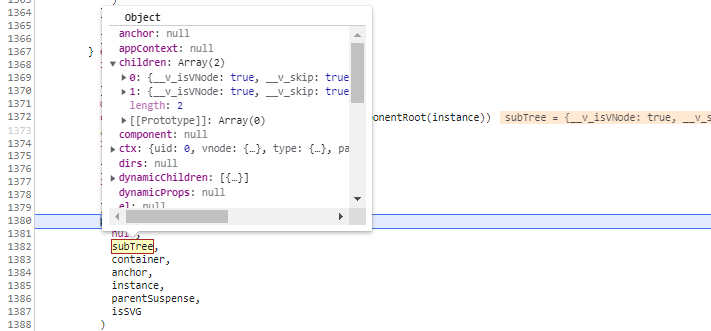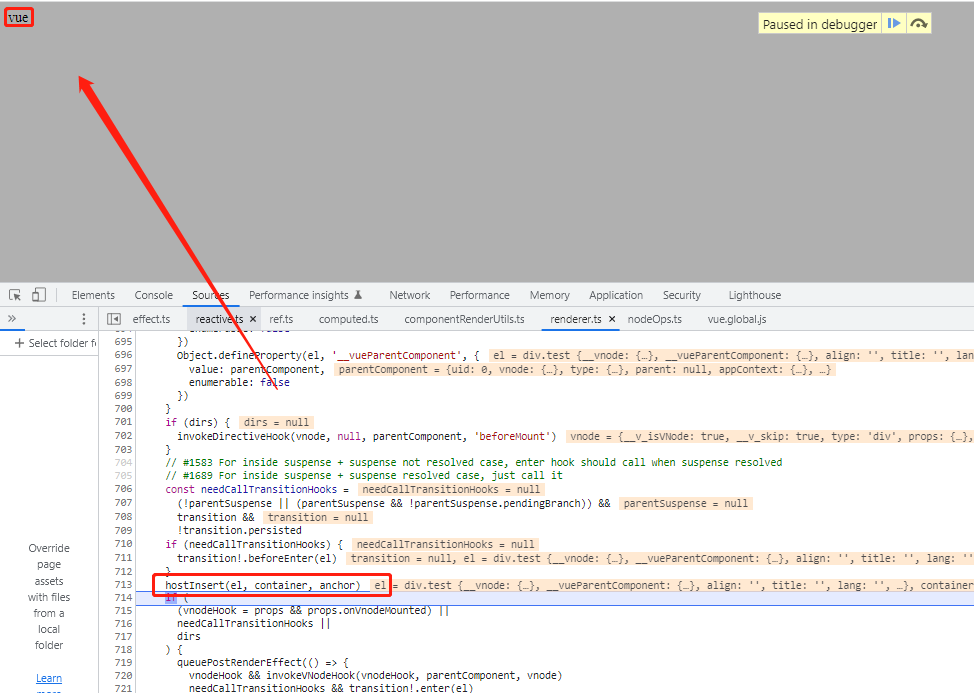Appearance
vnode渲染真实dom
- Vue执行完初始化,生成render函数之后,执行
setupRenderEffect函数,封装componentUpdateFn函数(packages\runtime-core\src\renderer.ts) 作为一个渲染函数的ReactiveEffect实例
1-1. componentUpdateFn函数就是执行render函数生成vnode,变成把vnode渲染成真实DOM的最初始函数
1-2. 把生成的vnode,传入到patch,作为第二参数,开始渲染成真实DOM正式开始
js
patch(
null,
subTree,
container,
anchor,
instance,
parentSuspense,
isSVG
)
2:以下面代码为例,得到subTree是一个对象,type为Symbol(Fragment),有children, dynamicChildren属性

2-1:传入到patch函数之后,vnode的type类型,为Fragment,执行processFragment n1:null n2: render函数生成vnode container: id为app的html对象 anchor: null parentComponent: vue的实例 isSVG:false slotScopeIds: null optimized: true
js
processFragment(
n1,
n2,
container,
anchor,
parentComponent,
parentSuspense,
isSVG,
slotScopeIds,
optimized
)
2-2. 因为n1是null,所以执行mountChildren,vnode的children作为第一参数,#app元素对象为第二参数
js
if (n1 == null) {
hostInsert(fragmentStartAnchor, container, anchor)
hostInsert(fragmentEndAnchor, container, anchor)
// a fragment can only have array children
// since they are either generated by the compiler, or implicitly created
// from arrays.
mountChildren(
n2.children as VNodeArrayChildren,
container,
fragmentEndAnchor,
parentComponent,
parentSuspense,
isSVG,
slotScopeIds,
optimized
)
}
2-3. mountChildren函数遍历vnode的children数组
拿到数组的第一个数组,传入patch作为第二参数,第一个参数为null
开始又一次执行patch函数
js
const mountChildren: MountChildrenFn = (
children,
container,
anchor,
parentComponent,
parentSuspense,
isSVG,
slotScopeIds,
optimized,
start = 0
) => {
for (let i = start; i < children.length; i++) {
const child = (children[i] = optimized
? cloneIfMounted(children[i] as VNode)
: normalizeVNode(children[i]))
patch(
null,
child,
container,
anchor,
parentComponent,
parentSuspense,
isSVG,
slotScopeIds,
optimized
)
}
}
2-4:获取type的类型为div,因此判断shapeFlag的类型为17,既为html元素类型 执行processElement函数 n1:null n2: vnode.children第一个数组 container: id为app的html对象 anchor: null parentComponent: vue的实例 isSVG:false slotScopeIds: null optimized: true
js
if (shapeFlag & ShapeFlags.ELEMENT) {
processElement(
n1,
n2,
container,
anchor,
parentComponent,
parentSuspense,
isSVG,
slotScopeIds,
optimized
)
}
2-5. 执行processElement函数,因为第一个n1参数为null,因此执行mountElement
js
const processElement = (
n1: VNode | null,
n2: VNode,
container: RendererElement,
anchor: RendererNode | null,
parentComponent: ComponentInternalInstance | null,
parentSuspense: SuspenseBoundary | null,
isSVG: boolean,
slotScopeIds: string[] | null,
optimized: boolean
) => {
isSVG = isSVG || (n2.type as string) === 'svg'
if (n1 == null) {
mountElement(
n2,
container,
anchor,
parentComponent,
parentSuspense,
isSVG,
slotScopeIds,
optimized
)
} else {
patchElement(
n1,
n2,
parentComponent,
parentSuspense,
isSVG,
slotScopeIds,
optimized
)
}
}
5-7. mountElement首先根
据n2参数执行
hostCreateElement函数创建一个html元素(packages\runtime-dom\src\nodeOps.ts)判断n2的
shapeFlag类型(packages\shared\src\shapeFlags.ts),如果是9,则为元素插入文本节点如果n2的
shapeFlag类型为17,执行mountChildren函数传入chidren数组
js
el = vnode.el = hostCreateElement(
vnode.type as string,
isSVG,
props && props.is,
props
)
if (shapeFlag & ShapeFlags.TEXT_CHILDREN) {
hostSetElementText(el, vnode.children as string)
} else if (shapeFlag & ShapeFlags.ARRAY_CHILDREN) {
mountChildren(
vnode.children as VNodeArrayChildren,
el,
null,
parentComponent,
parentSuspense,
isSVG && type !== 'foreignObject',
slotScopeIds,
optimized
)
}
5-7-1. 如有props有值,如class, style等,给元素设置属性
js
if (props) {
for (const key in props) {
if (key !== 'value' && !isReservedProp(key)) {
hostPatchProp(
el,
key,
null,
props[key],
isSVG,
vnode.children as VNode[],
parentComponent,
parentSuspense,
unmountChildren
)
}
}
5-7-2. 执行hostInsert(el, container, anchor)既把创建的新元素对象,插入到container里面,
container可以理解为#app的元素对象
- 这时候页面就可以显示内容了,手续的内容也是这样子逐渐展示

总结
通过递归遍历vnode来渲染dom 类似于:patch->processFragment->mountChildren(遍历children数组)->patch->processElement->mountElement->mountChildren->patch
递归执行,最终一步一步把vnode的内容渲染成真实DOM
相关代码
html
<!DOCTYPE html>
<html lang="en">
<head>
<meta charset="UTF-8">
<meta name="viewport" content="width=device-width, initial-scale=1.0">
<title>Document</title>
<script src="../../dist/vue.global.js"></script>
</head>
<body>
<div id="app">
<div class="test" style="font-size: 14px;">
<div>{{msg}}</div>
</div>
<div>stasut</div>
</div>
<script>
const { createApp } = Vue;
var app = createApp({
data() {
return {
msg: 'vue'
}
},
})
app.mount('#app')
</script>
</body>
</html>